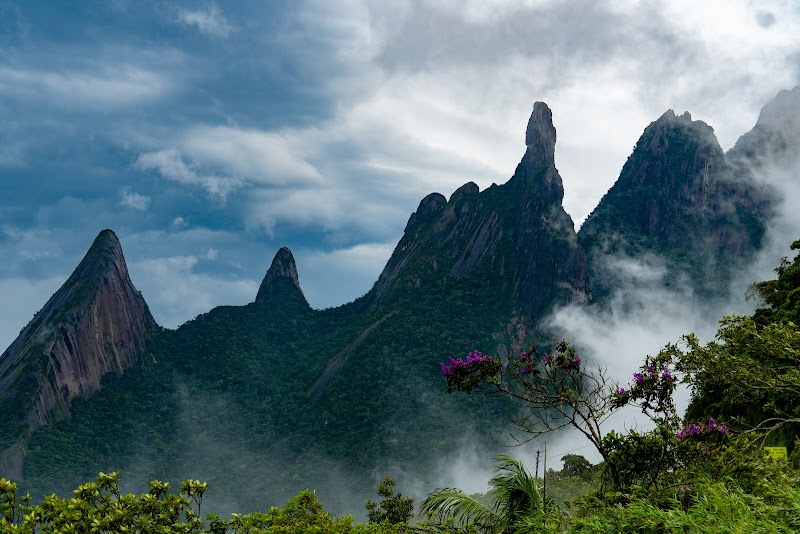Ascending Dedo de Deus: Your Adventure to Rio’s Iconic Peak
Dedo de Deus peak in Guapimirim offers an exhilarating hike with striking panoramic views of the surrounding valleys and Atlantic Forest. This trail balances challenging terrain with rich natural beauty, inviting adventurers to experience Rio de Janeiro’s wild side firsthand.
Start Early to Beat Heat and Crowds
Begin your hike at dawn when temperatures are cooler and the forest is alive with wildlife activity. This also reduces exposure to afternoon rain showers common in the area.
Wear Sturdy Hiking Boots
The trail includes rocky terrain and slippery roots. Supportive, grippy footwear is essential to avoid injury and maintain steady footing.
Carry at Least 2 Liters of Water
Humidity rises quickly, making hydration mandatory. There are no water points on the trail, so bring enough for the round trip.
Use Bug Repellent and Sun Protection
The forest shelters biting insects, and the open summit exposes you to strong UV rays. Apply repellent and wear sunscreen before setting out.
Ascending Dedo de Deus: Your Adventure to Rio’s Iconic Peak
The rugged silhouette of Dedo de Deus—"God's Finger"—stands jutting sharply above the verdant canopy of Guapimirim in Rio de Janeiro’s striking Serra dos Órgãos range. Hiking to its peak is a blend of challenge and reward, where each step pushes you closer to commanding vistas of rolling valleys draped in unshaken wilderness. The trail stretches approximately 8 kilometers round-trip with a 700-meter elevation gain, threading through dense Atlantic Forest, its leaves whispering with the wind’s steady breath. You’ll navigate rocky outcrops, roots gripping the soil like the mountain itself dares you to press forward, and patches where moss softens the ground underfoot.
Prepare for a hike that demands firm footwear and solid stamina. The path alternates between steep inclines and gentler plateaus, testing your balance over loose stones and narrow ledges. Starting early in the day is wise—morning air cuts cool and clear, the sun peeling back mist that clings to valley floors like a secret. Hydration is non-negotiable, as the humidity can rise sharply by afternoon. Along the way, listen for the calls of toucans and look for fleeting glimpses of howler monkeys amidst the trees; the forest keeps its residents both hidden and alive.
At the summit, Dedo de Deus rewards your effort with an uncompromising panorama. The valleys unfold beneath you, rivers threading silver lines through green expanses, while nearby peaks hum in quiet solidarity. This peak is fiercely itself—grand, demanding respect without bowing to the crowd. Don’t just soak in the view—take a moment to appreciate the mountain’s endurance and the ecosystem it shields. For planning: map the trail carefully, pack layers for shifting weather, and respect local guidelines that emphasize Leave No Trace principles. This hike combines the thrill of physical challenge with nature’s raw spectacle, an accessible yet authentic adventure for both avid and casual hikers seeking a memorable escape from urban sprawl.
Nearby Trips
All Adventures
Boat Charters
Water Activities
Adventures near Teresópolis
Discover the unique and memorable adventures that make Teresópolis special.
Frequently Asked Questions
How difficult is the hike to Dedo de Deus peak?
It is considered a moderate hike, with a round-trip distance of about 8 kilometers and a 700-meter elevation gain, requiring good fitness, surefootedness, and basic navigation skills.
Is it safe to hike alone?
While possible, it’s recommended to hike with a partner or group because of technical sections. Mobile signal may be spotty, so taking a guide or informing others of your route adds safety.
What permits or fees are required?
There is a small entrance fee to access Serra dos Órgãos National Park, where the hike is located. Tickets can be purchased onsite or sometimes online through official channels.
Can the hike be done year-round?
Yes, but best avoided in peak summer afternoons due to intense heat and storms. Winter and fall offer more stable weather, while spring and summer bring lush landscapes and occasional rain.
Are there marked trails or signs?
The trail is moderately marked but can be confusing in places. Maps or GPS navigation apps and local knowledge improve route-finding reliability.
What wildlife might I encounter?
Toucans, howler monkeys, small marsupials, and various non-aggressive snakes are inhabitants of the area. The wildlife is generally shy but audible throughout the forest sections.
Recommended Gear
Hiking Boots
Provides needed ankle support and traction over rocky and root-covered terrain.
Hydration System or Water Bottles
Critical to avoid dehydration in humid forest conditions with no water refill points.
Light Rain Jacket
Protects from sudden tropical showers often occurring during warmer months.
Sun Hat and Sunscreen
Shields against strong sun exposure especially at exposed summit areas.
Local Insights
Hidden Gems
- "Mirante do Último Adeus – a less crowded viewpoint with a stunning peek into the adjacent valleys."
- "Small natural pools near the trailhead offering refreshing stops on warm days."
Wildlife
- "Black-fronted piping guan and rare maned sloths are sometimes spotted by attentive hikers."
- "Various species of orchids bloom along less-traveled trails in spring."
History
"Dedo de Deus is iconic to Brazilian mountaineering history, inspiring early rock climbers and symbolizing the Serra dos Órgãos park’s natural heritage established in 1939."
